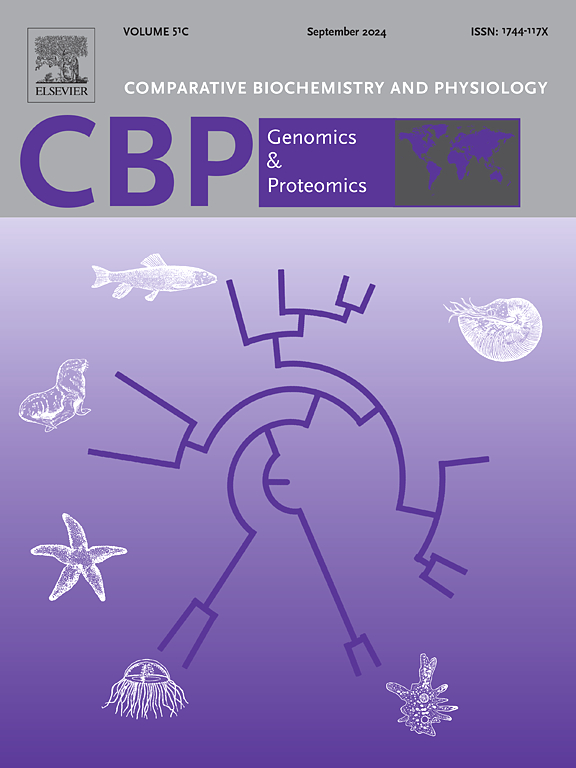Non-targeted metabolomics studies revealed the effects of environmentally relevant concentrations of perfluorooctane sulfonic acid (PFOS) on carbohydrate metabolism in red claw crayfish (Cherax quadricarinatus)
IF 2.2
2区 生物学
Q4 BIOCHEMISTRY & MOLECULAR BIOLOGY
Comparative Biochemistry and Physiology D-Genomics & Proteomics
Pub Date : 2025-06-12
DOI:10.1016/j.cbd.2025.101548
引用次数: 0
Abstract
Perfluorooctane sulfonate (PFOS), a persistent organic pollutant, poses significant threats to aquatic ecosystems and organisms. This study investigated the biological effects of environmentally relevant PFOS concentrations (0 ng/L, 1 ng/L, 10 μg/L) on Cherax quadricarinatus, a freshwater crayfish of economic importance, focusing on histopathology, apoptosis (via TUNEL staining), and metabolomic alterations. The results showed that PFOS exposure caused tissue damage to the hepatopancreas of C. quadricarinatus, and PFOS exposure caused apoptosis of C. quadricarinatus hepatopancreas. In addition, the metabolomics results showed that there were several significant differential metabolites and metabolic pathways, which indicated that PFOS exposure can cause metabolic disorders in the hepatopancreas of C. quadricarinatus. The Starch and sucrose metabolism pathway was significantly enriched in both groups, suggesting the potential role of this pathway in the biological effects of PFOS on C. quadricarinatus. In addition, in 1 ng/L group, four significant differential metabolic pathways: Glucagon signaling pathway, Glycerolipid metabolism, Starch and sucrose metabolism, and Glycolysis/Gluconeogenesis were found, which demonstrated the adverse effects of PFOS even at environmental relevant concentration. Furthermore, in all the four metabolic pathways, glucose-1-phosphate is the only mutual significant differential metabolite, indicating that the carbohydrate metabolism might be the target affecting pathway and the glucose-1-phosphate assumed an important role in the metabolic effect of environmental relevant concentration of PFOS. This study revealed the effect of PFOS on C. quadricarinatus through tissue physiology and combined with metabolomics, which is of great significance for exploring the practical biological effects and health risk of PFOS in the actual aquatic environment.

非靶向代谢组学研究揭示了环境相关浓度的全氟辛烷磺酸(PFOS)对红爪小龙虾(Cherax quadricarinatus)碳水化合物代谢的影响
全氟辛烷磺酸(PFOS)是一种持久性有机污染物,对水生生态系统和生物构成重大威胁。本研究研究了环境相关浓度(0 ng/L、1 ng/L、10 μg/L)对具有重要经济价值的淡水螯虾(Cherax quadricarinatus)的生物学效应,重点研究了组织病理学、细胞凋亡(通过TUNEL染色)和代谢组学改变。结果表明,全氟辛烷磺酸暴露可引起四头海棠肝胰脏组织损伤,引起四头海棠肝胰脏细胞凋亡。此外,代谢组学结果显示,存在几种显著差异的代谢物和代谢途径,这表明PFOS暴露可引起四角弓根肝胰腺代谢紊乱。淀粉和蔗糖代谢途径在两组中均显著富集,提示该途径可能参与了PFOS对四角曲蝇的生物学效应。此外,在1 ng/L组中,发现了4条显著差异的代谢途径:胰高血糖素信号通路、甘油脂代谢、淀粉和蔗糖代谢以及糖酵解/糖异生,这表明即使在环境相关浓度下,PFOS也会产生不利影响。此外,在四种代谢途径中,葡萄糖-1-磷酸是唯一的相互显著差异代谢物,表明碳水化合物代谢可能是影响途径的目标,葡萄糖-1-磷酸在环境相关浓度的全氟辛烷磺酸代谢效应中起重要作用。本研究通过组织生理学并结合代谢组学,揭示了PFOS对四角棘鱼的影响,对于探索PFOS在实际水生环境中的实际生物学效应和健康风险具有重要意义。
本文章由计算机程序翻译,如有差异,请以英文原文为准。
求助全文
约1分钟内获得全文
求助全文
来源期刊
CiteScore
5.10
自引率
3.30%
发文量
69
审稿时长
33 days
期刊介绍:
Comparative Biochemistry & Physiology (CBP) publishes papers in comparative, environmental and evolutionary physiology.
Part D: Genomics and Proteomics (CBPD), focuses on “omics” approaches to physiology, including comparative and functional genomics, metagenomics, transcriptomics, proteomics, metabolomics, and lipidomics. Most studies employ “omics” and/or system biology to test specific hypotheses about molecular and biochemical mechanisms underlying physiological responses to the environment. We encourage papers that address fundamental questions in comparative physiology and biochemistry rather than studies with a focus that is purely technical, methodological or descriptive in nature.

 求助内容:
求助内容: 应助结果提醒方式:
应助结果提醒方式:


